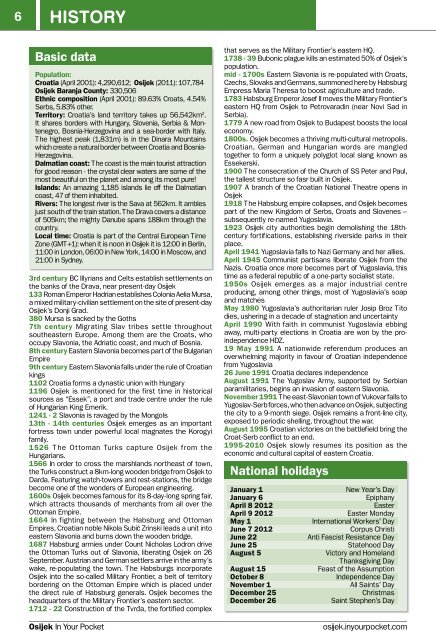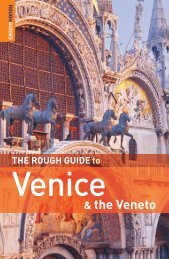Create successful ePaper yourself
Turn your PDF publications into a flip-book with our unique Google optimized e-Paper software.
6 HISTORYCulture & Events7Basic dataPopulation:Croatia (April 2001): 4,290,612; Osijek (2011): 107,784Osijek Baranja County: 330,506Ethnic composition (April 2001): 89.63% Croats, 4.54%Serbs, 5.83% other.Territory: Croatia’s land territory takes up 56,542km 2 .It shares borders with Hun gary, Slovenia, Serbia & Montenegro,Bosnia-Herzegovina and a sea-border with Italy.The highest peak (1,831m) is in the Dinara Mountainswhich create a natural border between Croatia and Bosnia-Herzegovina.Dalmatian coast: The coast is the main tourist attractionfor good reason - the crystal clear wa ters are some of themost beautiful on the planet and among its most pure!Islands: An amazing 1,185 islands lie off the Dalmatiancoast, 47 of them inhabited.Rivers: The longest river is the Sava at 562km. It amblesjust south of the train station. The Drava covers a dis tanceof 505km; the mighty Danube spans 188km through thecountry.Local time: Croatia is part of the Central Eu ro pean TimeZone (GMT+1): when it is noon in Osijek it is 12:00 in Berlin,11:00 in London, 06:00 in New York, 14:00 in Moscow, and21:00 in Sydney.3rd century BC Illyrians and Celts establish settlements onthe banks of the Drava, near present-day Osijek133 Roman Emperor Hadrian establishes Colonia Aelia Mursa,a mixed military-civilian settlement on the site of present-dayOsijek’s Donji Grad.380 Mursa is sacked by the Goths7th century Migrating Slav tribes settle throughoutsoutheastern Europe. Among them are the Croats, whooccupy Slavonia, the Adriatic coast, and much of Bosnia.8th century Eastern Slavonia becomes part of the BulgarianEmpire9th century Eastern Slavonia falls under the rule of Croatiankings1102 Croatia forms a dynastic union with Hungary1196 Osijek is mentioned for the first time in historicalsources as “Essek”, a port and trade centre under the ruleof Hungarian King Emerik.1241 - 2 Slavonia is ravaged by the Mongols13th - 14th centuries Osijek emerges as an importantfortress town under powerful local magnates the Korogyifamily.1526 The Ottoman Turks capture Osijek from theHungarians.1566 In order to cross the marshlands northeast of town,the Turks construct a 8km-long wooden bridge from Osijek toDarda. Featuring watch-towers and rest-stations, the bridgebecome one of the wonders of European engineering.1600s Osijek becomes famous for its 8-day-long spring fair,which attracts thousands of merchants from all over theOttoman Empire.1664 In fighting between the Habsburg and OttomanEmpires, Croatian noble Nikola Subić Zrinski leads a unit intoeastern Slavonia and burns down the wooden bridge.1687 Habsburg armies under Count Nicholas Lodron drivethe Ottoman Turks out of Slavonia, liberating Osijek on 26September. Austrian and German settlers arrive in the army’swake, re-populating the town. The Habsburgs incorporateOsijek into the so-called Military Frontier, a belt of territorybordering on the Ottoman Empire which is placed underthe direct rule of Habsburg generals. Osijek becomes theheadquarters of the Military Frontier’s eastern sector.1712 - 22 Construction of the Tvrđa, the fortified complexthat serves as the Military Frontier’s eastern HQ.1738 - 39 Bubonic plague kills an estimated 50% of Osijek’spopulation.mid - 1700s Eastern Slavonia is re-populated with Croats,Czechs, Slovaks and Germans, summoned here by HabsburgEmpress Maria Theresa to boost agriculture and trade.1783 Habsburg Emperor Josef II moves the Military Frontier’seastern HQ from Osijek to Petrovaradin (near Novi Sad inSerbia).1779 A new road from Osijek to Budapest boosts the localeconomy.1800s. Osijek becomes a thriving multi-cultural metropolis.Croatian, German and Hungarian words are mangledtogether to form a uniquely polyglot local slang known asEssekerski.1900 The consecration of the Church of SS Peter and Paul,the tallest structure so fasr built in Osijek.1907 A branch of the Croatian National Theatre opens inOsijek1918 The Habsburg empire collapses, and Osijek becomespart of the new Kingdom of Serbs, Croats and Slovenes –subsequently re-named Yugoslavia.1923 Osijek city authorities begin demolishing the 18thcenturyfortifications, establishing riverside parks in theirplace.April 1941 Yugoslavia falls to Nazi Germany and her allies.April 1945 Communist partisans liberate Osijek from theNazis. Croatia once more becomes part of Yugoslavia, thistime as a federal republic of a one-party socialist state.1950s Osijek emerges as a major industrial centreproducing, among other things, most of Yugoslavia’s soapand matchesMay 1980 Yugoslavia’s authoritarian ruler Josip Broz Titodies, ushering in a decade of stagnation and uncertaintyApril 1990 With faith in communist Yugoslavia ebbingaway, multi-party elections in Croatia are won by the proindependenceHDZ.19 May 1991 A nationwide referendum produces anoverwhelming majority in favour of Croatian independencefrom Yugoslavia26 June 1991 Croatia declares independenceAugust 1991 The Yugoslav Army, supported by Serbianparamilitaries, begins an invasion of eastern Slavonia.November 1991 The east-Slavonian town of Vukovar falls toYugoslav-Serb forces, who then advance on Osijek, subjectingthe city to a 9-month siege. Osijek remains a front-line city,exposed to periodic shelling, throughout the war.August 1995 Croatian victories on the battlefield bring theCroat-Serb conflict to an end.1995-2010 Osijek slowly resumes its position as theeconomic and cultural capital of eastern Croatia.National holidaysJanuary 1January 6April 8 2012April 9 2012May 1June 7 2012June 22June 25August 5August 15October 8November 1December 25December 26New Year’s DayEpiphanyEasterEaster MondayInternational Workers' DayCorpus ChristiAnti Fascist Resistance DayStatehood DayVictory and HomelandThanksgiving DayFeast of the AssumptionIndependence DayAll Saints’ DayChristmasSaint Stephen’s DayOsijek Summer Nightswww.tz<strong>osijek</strong>.hr. These nights are usually held on thelast Friday in June, July and August and at the differentcity locations. There is entertainment for the little onesand adults alike, ranging from plays, concerts, streetentertainers to culinary presentations. The dates maychange, weather permitting.Exhibitions06.05.2011. Friday - 29.01.2012. SundayThe History of radio in OsijekF-2, Museum of Slavonia, Trg Svetog Trojstva 6, Tvrđa,tel. (+385-31) 25 07 30, muzej-slavonije@mso.hr, www.mso.hr. All we here is, radio gaga! That great Queen track stillhits the airwaves today and this exhibition is devoted to theintroduction and progress of radio in Osijek which began in1943 during WWII. Relive programmes that included politics,economy, culture and art in the early days, to 24hour coverageof the Homeland War, to internet radio stations, and more.It is a radio paradise!30.06 Thursday - 11.09 SundayIvan SarićF-2, Museum of Slavonia, Trg Svetog Trojstva 6, Tvrđa,tel. (+385-31) 25 07 30, muzej-slavonije@mso.hr, www.mso.hr. Ivan Sarić could be claimed as a bit of a daredevil inhis time, this Croat (1876-1966) from Subotica lived for theday. He was a pilot, athlete, cyclist and motorcyclist. He isespecially famous for his pioneering role as an airman andlater became famous for making a flight by monoplane overthe Subotica horse racing track distancing 3km, on October16, 1910. In fact, he built that monoplane himself.07.07 Thursday - 31.08 WednesdayDarko Glavan and the Osijek Art SceneF-2, Osijek Art Gallery, Europska avenija 9, tel. (+385-31) 25 12 80; 25 12 87, gluo@gluo.hr, www.gluo.hr.In many ways Darko Glavan was the guru of Osijek art, thisart critic passionately conducted his work. He wrote aboutartists, nominated them for awards and recommended themto other custodians and critics. He knew the Osijek art sceneinside out and it is here that five artists: Mario Čaušić, TihomirMatijević, Mile Nekić, Domagoj Sušac and Ratko Žaja presenttheir works whilst accompanied by Glavan’s texts from yearsback which are a reminder of his knowledge and persona.Osijek Antique MarketOsječki sajam antikvitetaF-2, Trg Svetog Trojstva, tel.(+385-31) 20 37 55. Th ebuildings aren’t the only old thingsto be found in the Tvrđa. On thefirst Saturday of each month,antique dealers from Croatia andsurrounding countries descend onTrg Svetog Trojstva to peddle theirtreasures. The Osijek AntiquesMarket, organized by the City of Osijek, Glas Slavonijeand the Osijek Tourist Board, opened in 2005 in front ofthe Bastion and then moved to the Tvrđa’s main square.It attracts sellers from Hungary, Serbia, Bosnia andHerzegovina as well as Croatia who offer antique furniture,porcelain, paintings, clocks, coins, and antique weaponsand other collectibles. QOpen 09:00 - 15:00.Osijek In Your Pocket<strong>osijek</strong>.inyourpocket.com<strong>osijek</strong>.inyourpocket.com2011 / 2012







